The calorific value of different types of fuel: a comparison of fuel by calorific value + table of calorific value
When a certain amount of fuel burns out, a measurable amount of heat is released. According to the International System of Units, the value is expressed in Joules per kg or m3. But the parameters can be calculated in kcal or kW. If the value is related to the unit of fuel, it is called specific.
What affects the calorific value of various fuels? What is the value of the indicator for liquid, solid and gaseous substances? Answers to these questions are detailed in the article. In addition, we have prepared a table showing the specific heat of combustion of materials - this information is useful when choosing a high-energy type of fuel.
The content of the article:
General information on calorific value
The energy release during combustion should be characterized by two parameters: high efficiency and the absence of the production of harmful substances.
Artificial fuel is obtained in the process of processing natural - biofuel. Regardless of the state of aggregation, the substances in their chemical composition have a combustible and non-combustible part. The first is carbon and hydrogen. The second consists of water, mineral salts, nitrogen, oxygen, metals.

When 1 kg of such a “mixture” is burned, a different amount of energy is released. How much of this particular energy will be released depends on the proportions of these elements - the combustible part, humidity, ash content and other components.
The heat of combustion of fuel (TST) is formed from two levels - the highest and the lowest. The first indicator is obtained due to condensation of water, in the second this factor is not taken into account.
Lower TST is needed for calculating the need for fuel and its cost, with the help of such indicators heat balances are compiled and the efficiency of fuel-powered plants is determined.
TST can be calculated analytically or experimentally.If the chemical composition of the fuel is known, the Mendeleev formula is used. Experimental techniques are based on the actual measurement of heat during fuel combustion.
In these cases, a special burning bomb is used - a calorimetric bomb along with a calorimeter and a thermostat.
Features of the calculations are individual for each type of fuel. Example: TST in internal combustion engines is calculated from the lowest value, because the liquid does not condense in the cylinders.
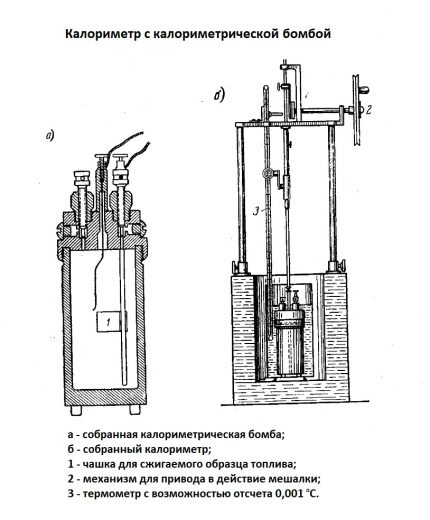
Each type of substance has its own TST due to its chemical composition. The values vary significantly, the range of fluctuations is 1 000-10 000 kcal / kg.
Comparing different types of materials, the concept of conventional fuel is used; it is characterized by a lower TST of 29 MJ / kg.
Calorific value of solid materials
This category includes wood, peat, coke, oil shale, briquette and pulverized fuel. The bulk of solid fuel is carbon.
Features of different species of wood
The maximum efficiency from the use of firewood is achieved if two conditions are met - dry wood and a slow burning process.
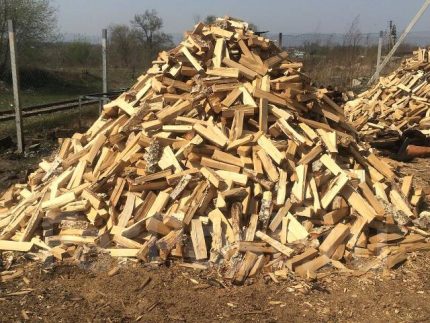
Ideal for wood stove heating Oak, birch, ash blocks are considered. Good performance is characterized by hawthorn, hazel. But in conifers, the calorific value is low, but the burning rate is high.
How different breeds burn:
- Beech, birch, ash, hazel difficult to melt, but they can burn raw due to their low moisture content.
- Alder with aspen they do not form soot and “know how” to remove it from the chimney.
- Birch tree It requires a sufficient amount of air in the furnace, otherwise it will smoke and settle with resin on the walls of the pipe.
- Pine contains more resin than spruce, so it sparks and burns hotter.
- Pear and apple tree it breaks more easily and burns perfectly.
- Cedar gradually turns into smoldering coal.
- Cherry and Elm smokes, and the plane tree is difficult to split.
- Linden tree with poplar burn out quickly.
TST indices of different breeds strongly depend on the density of specific breeds. 1 cubic meter of firewood is equivalent to approximately 200 liters of liquid fuel and 200 m3 natural gas. Wood and firewood are low energy efficient.
The effect of age on the properties of coal
Coal is a natural material of plant origin. It is extracted from sedimentary rocks. This fuel contains carbon and other chemical elements.
In addition to the type, the age of the material also affects the calorific value of coal. Brown belongs to the young category, followed by stone, and the oldest is considered anthracite.
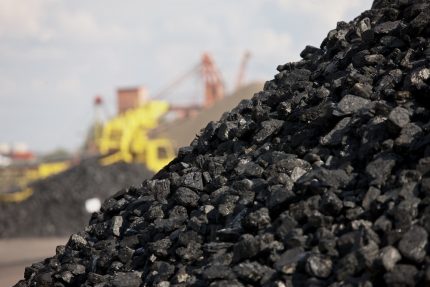
The process of burning coal is accompanied by the release of substances polluting the environment, while the grate of the boiler is covered with slag. Another adverse factor for the atmosphere is the presence of sulfur in the fuel. This element in contact with air is transformed into sulfuric acid.
Manufacturers manage to minimize the sulfur content in coal. As a result, TJT differs even within the same species. Affects the performance and geography of production. As solid fuel, not only pure coal, but also briquetted slag can be used.
The greatest fuel ability is observed in coking coal. Stone, wood, lignite, and anthracite also have good characteristics.
Characteristics of pellets and briquettes
This solid fuel is manufactured industrially from various wood and vegetable debris.
Shredded chips, bark, cardboard, straw are dried and with special equipment turns into granules. In order for the mass to acquire a certain degree of viscosity, a polymer - lignin is added to it.
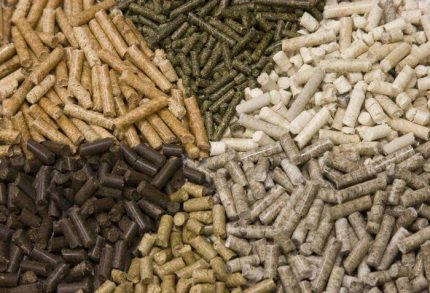
Briquettes differ only in shape, they can be loaded into ovens, boilers. Both types of fuel are divided into types of raw materials: from round logs, peat, sunflower, straw.
At pellets and briquettes There are significant advantages over other types of fuel:
- full environmental friendliness;
- the ability to store in almost any environment;
- resistance to mechanical stress and fungus;
- uniform and long burning;
- optimal pellet size for loading into a heating device.
Sustainable fuels are a good alternative to traditional heat sources that are not renewable and adversely affect the environment. But pellets and briquettes are characterized by increased fire hazard, which should be taken into account when organizing a storage location.
If you wish, you can arrange the production of fuel briquettes with your own hands, more details - in this article.
Liquid Parameters
Liquid materials, like solid ones, are decomposed into the following components: carbon, hydrogen, sulfur, oxygen, nitrogen. The percentage is expressed by weight.
From oxygen and nitrogen, internal organic fuel ballast is formed, these components do not burn and are included in the composition conditionally. External ballast is formed from moisture and ash.
High specific heat of combustion is observed in gasoline. Depending on the brand, it is 43-44 MJ.
Similar specific heat values of combustion are also determined for aviation kerosene - 42.9 MJ. In terms of calorific value, diesel fuel also falls into the category of leaders - 43.4-43.6 MJ.

Relatively low TST values are characterized by liquid rocket fuel, ethylene glycol. The minimum specific heat of combustion is distinguished by alcohol and acetone. Their performance is significantly lower than that of traditional motor fuels.
Gaseous fuel properties
Gaseous fuel is composed of carbon monoxide, hydrogen, methane, ethane, propane, butane, ethylene, benzene, hydrogen sulfide and other components. These indicators are expressed as a percentage by volume.
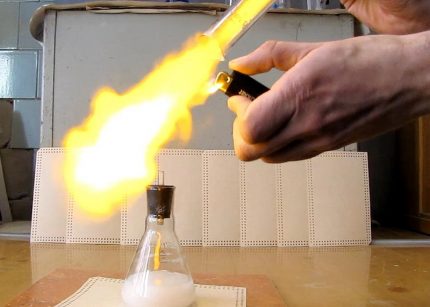
High calorific values are also observed in natural gas.
They are equal to 41-49 MJ per kg. But, for example, pure methane has a calorific value of more than 50 MJ per kg.
Comparison Chart
The table shows the values of the mass specific heat of combustion of liquid, solid, gaseous types of fuel.
| Type of fuel | Units rev. | Specific heat of combustion | ||
| MJ | kw | kcal | ||
| Firewood: oak, birch, ash, beech, hornbeam | kg | 15 | 4,2 | 2500 |
| Firewood: larch, pine, spruce | kg | 15,5 | 4,3 | 2500 |
| Brown coal | kg | 12,98 | 3,6 | 3100 |
| Coal | kg | 27,00 | 7,5 | 6450 |
| Charcoal | kg | 27,26 | 7,5 | 6510 |
| Anthracite | kg | 28,05 | 7,8 | 6700 |
| Wood Pellet | kg | 17,17 | 4,7 | 4110 |
| Straw pellet | kg | 14,51 | 4,0 | 3465 |
| Sunflower pellet | kg | 18,09 | 5,0 | 4320 |
| Sawdust | kg | 8,37 | 2,3 | 2000 |
| Paper | kg | 16,62 | 4,6 | 3970 |
| Vine | kg | 14,00 | 3,9 | 3345 |
| Natural gas | m3 | 33,5 | 9,3 | 8000 |
| LPG | kg | 45,20 | 12,5 | 10800 |
| Petrol | kg | 44,00 | 12,2 | 10500 |
| Diz. fuel | kg | 43,12 | 11,9 | 10300 |
| Methane | m3 | 50,03 | 13,8 | 11950 |
| Hydrogen | m3 | 120 | 33,2 | 28700 |
| Kerosene | kg | 43.50 | 12 | 10400 |
| Fuel oil | kg | 40,61 | 11,2 | 9700 |
| Oil | kg | 44,00 | 12,2 | 10500 |
| Propane | m3 | 45,57 | 12,6 | 10885 |
| Ethylene | m3 | 48,02 | 13,3 | 11470 |
From the table it can be seen that the highest TST indicators of all substances, and not just from gaseous ones, have hydrogen. It refers to high-energy fuels.
The product of hydrogen combustion is ordinary water. In the process, furnace waste, ash, carbon monoxide and carbon dioxide are not emitted, which makes the substance environmentally friendly fuel.But it is explosive and has a low density, so this fuel is difficult to liquefy and transported.
Conclusions and useful video on the topic
About the calorific value of different species of wood. Comparison of indicators per m3 and kg
TST is the most important thermal and operational characteristic of fuel. This indicator is used in various fields of human activity: heat engines, power plants, industry, when heating homes and cooking.
Calorific values help to compare different types of fuel according to the degree of energy released, calculate the required mass of fuel, save on costs.
Is there anything to supplement, or have questions about the calorific value of different types of fuel? You can leave comments on the publication and participate in discussions - the contact form is in the bottom block.

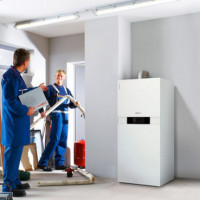 Autonomous heating in the apartment: a comparison of various options for the arrangement
Autonomous heating in the apartment: a comparison of various options for the arrangement  Pressed sawdust for heating: advantages with disadvantages + comparison with traditional solid fuels
Pressed sawdust for heating: advantages with disadvantages + comparison with traditional solid fuels 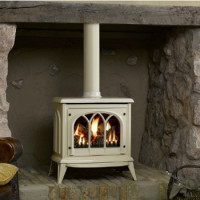 How to make a chimney for a fireplace: the rules of the device of the smoke channel and a comparison of designs
How to make a chimney for a fireplace: the rules of the device of the smoke channel and a comparison of designs 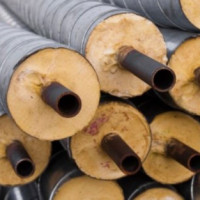 Insulation for heating pipes: overview of types + application examples
Insulation for heating pipes: overview of types + application examples 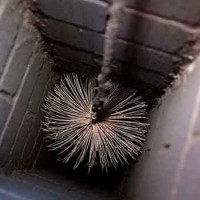 How to clean the chimney from soot: how to properly clean the chimney
How to clean the chimney from soot: how to properly clean the chimney 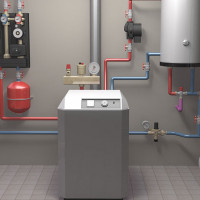 Economical heating of a private house: choosing the most economical heating system
Economical heating of a private house: choosing the most economical heating system  How much does it cost to connect gas to a private house: the price of organizing gas supply
How much does it cost to connect gas to a private house: the price of organizing gas supply  The best washing machines with dryer: model rating and customer tips
The best washing machines with dryer: model rating and customer tips  What is the color temperature of light and the nuances of choosing the temperature of the lamps to suit your needs
What is the color temperature of light and the nuances of choosing the temperature of the lamps to suit your needs  Replacement of a geyser in an apartment: replacement paperwork + basic norms and requirements
Replacement of a geyser in an apartment: replacement paperwork + basic norms and requirements
Yes ... maybe we will live to see hydrogen boilers becoming commonplace - a dream!
Of course, drowning with main gas is the best option, but, unfortunately, in our vast country it is not accessible to everyone. And if you choose between coal and pellets, I choose pellets. Coal also emits a lot of harmful substances in the combustion process, and then slag needs to be put somewhere else. And the whole country pours it on the road in winter, and then breathes carcinogenic dust in spring, and then wonders why it is so sick.
Ashes from pellets can be fertilized garden, well, or a lawn - whoever has what.
The best firewood comes from deciduous trees - oak, birch. Of birch, the most versatile and popular firewood is that it gives enough temperature, burns evenly, without a lot of smoke. Oak gives the most heat when compared with trees growing in our country. Aspen is good for clearing a chimney. I do not recommend drowning with conifers - because of the resins they give a lot of smoke.
I think it’s extremely unprofitable now to heat only with wood. The only where applicable is the bathhouse. And if we take the heating of a village house, then coal, whoever says anything, is still ahead of all types of fuel, with the exception of main gas. Gas in cylinders, gas holder, firewood, pellets, briquettes - all have cons. Somewhere a high price, somewhere a bureaucracy with a bunch of permits and passing checks. And in coal, I do not see any significant minuses. Of course, someday gasification is not in words, but in fact it will reach our villages and the relevance of coal will decrease, but it will not be soon.
For gasoline, diesel fuel, oil, kerosene ... data on KGS 😉
Yes, thanks, thanks! Corrected.
In the table, kcal is energy and kW is power. For example, 2500 kcal is 2.9075 kWh. Or am I wrong?